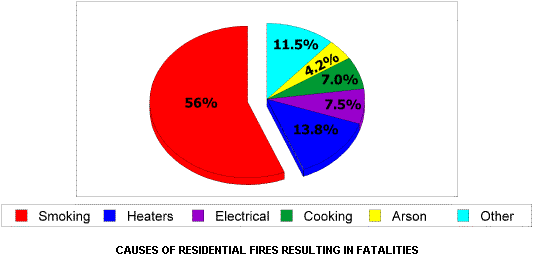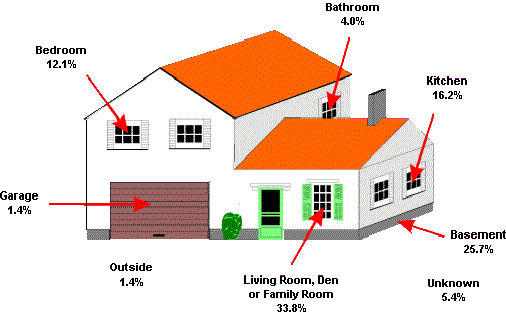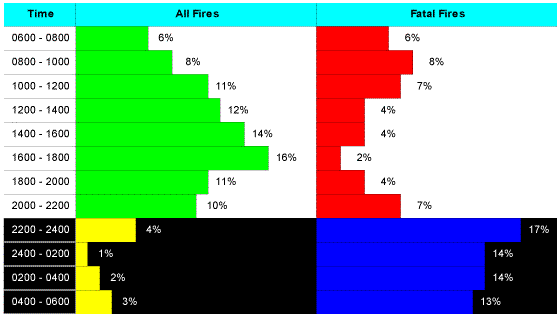FIRE PREVENTION AND PROTECTION FOR THE HOUSE OWNER |
|||
| Chapter One: Introduction | |||
| It is a fact that people are usually more concerned about security than they are about fire safety, yet fire can be much more devastating and life-threatening. Burglars will avoid conflict at all costs and will usually strike when they are convinced the house is unoccupied. Fires, on the other hand, can occur at any time, are usually caused by an act of carelessness, and most often develop while the house is occupied. You may lose everything during a fire, including personal items that insurance cannot replace (such as treasured photographs and letters); yet a burglar will steal only items that he can use or turn into ready cash. By all means, secure your home against burglary, but be aware of the greater danger of fire. | |||
| How fires start | Three conditions must exist before a fire can be started. First, there must be a substance that will burn. Secondly, there must be plenty of oxygen. Thirdly, the substance must be raised to its kindling temperature. Different materials have different kindling points - for example, the kindling point of paper is 184 degrees Centigrade, that of cotton is 228 degrees, and that of wood is 260 degrees. Fires can be started naturally (e.g. by lightning), or can be man-made (either intentionally or accidentally). Whereas most intentional fires are set to perform a task (e.g. to heat or to illuminate), some may be the work of an arsonist intent on destruction. Accidental fires are usually caused by negligence or by lack of knowledge, and it is these that most affect us as house owners. These are the fires we have the ability to prevent and to protect ourselves against, and are the ones covered by the scope of this document. | ||
| The dangers of fire | When the kindling temperature of a material or substance is reached it will ignite, producing flame, smoke, heat and fire gases. Each of these products of combustion can cause injury or death. Burns can be caused by direct contact with flames, or by the heat radiated from flames, but flames themselves are responsible for relatively few of the reported fire deaths. Smoke frequently provides the early warning of fire and is likely to cause panic and consequential injury due to the very nature of its blinding and irritating effects. Heat is mostly responsible for the spread of fire, but exposure to heated air can be very injurious to the body’s internal organs. However, it is generally recognised that the inhalation of heated, toxic and oxygen-deficient fire gases is responsible for the greatest number of fire fatalities. The chief danger in most fire gases is carbon monoxide (often called "the silent killer"), but many other poisonous fumes are produced by the burning of common household items. Gases given off by burning plastics and synthetic materials are particularly toxic. The victims usually do not sense the fire until it has gained some headway, by which time heat and smoke have made escape difficult. Often, people are overcome by smoke and toxic fumes while asleep or while trying to escape. Statistics indicate that, in one and two family residential dwellings, 74% of people die from asphyxiation, smoke inhalation, carbon monoxide poisoning, etc., while only 24% die from burns. The remaining 2% die from heart attack or other injuries. For this reason, early warning of a fire is essential. | ||
| Improving the odds | By analysing the three conditions required before a fire can start, we should be able to reduce the chances of an accidental fire happening in our homes. Firstly, it is virtually impossible to eliminate all combustible materials and substances from a house - practically all of our possessions will burn to some degree when exposed to flame or extreme heat. We can, however, eliminate many combustible materials that are no longer required (e.g.. garbage, waste paper, old newspapers) and properly store flammable substances. We can also select textiles (e.g.. clothing, bedding) and construction materials (e.g.. wood, paint, wallpaper) carefully, when purchasing these items. Secondly, the oxygen required to keep a fire alive is also required to keep us alive, so it is obviously not something we can eliminate - but it is possible to limit the speed with which oxygen can be fed to a fire by keeping doors closed at all times except when actually being used. This may allow the occupants of a burning house precious extra seconds in which to escape. Thirdly, we must keep the temperature of combustibles below the kindling point by ensuring that potential sources of ignition (e.g.. smoking materials, heaters, electrical equipment) are not used carelessly. Although we can considerably reduce the chances of a fire occurring, we must still prepare ourselves for that one time when the unexpected can happen. | ||
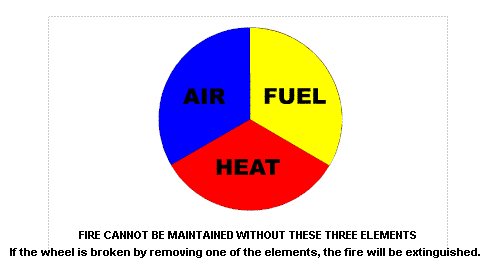 |
|||
| Fire in Canada | Carelessness and ignorance of fire safety have earned Canadians a ranking among the worst in the world for fire losses. In fact, an average of 75,000 fires are reported in Canada each year, resulting in 740 deaths, 5000 injuries and a property loss in the order of $758 million. Many of these fires could have been prevented with the proper knowledge, the proper equipment, and a little common sense. | ||
| The Power of Fire | |||
| The National Fire Protection Association produced a film entitled "Fire Power", in which a two-storey wood-framed house was destroyed by fire as a demonstration. The progress of the uncontrolled fire was closely monitored. | |||
| Demonstration | The demonstration began when an ashtray with a smouldering cigarette was dumped into a wastebasket in the living room. Approximately two minutes later the contents of the wastebasket started smouldering and five minutes after this the wastebasket was in flames. From the moment of the first flame, the progress of the fire was timed in minutes and seconds. | ||
| 0:30 | Burning material from the wastebasket ignites the nearby couch. | ||
| 1:04 | Polyurethane cushioning from the couch starts to melt, spreading fire to the carpet. Smoke begins to fill the living room. | ||
| 1:35 | Toxic gases leaving the living room are measured at a temperature of 88 degrees Centigrade (190 degrees Fahrenheit). | ||
| 1:47 | Light smoke begins to move to the second floor where the bedrooms are located. | ||
| 2:30 | Temperature above the burning couch reaches 204 degrees Centigrade (400 degrees Fahrenheit). | ||
| 2:48 | Smoke pours into the adjacent dining room only four feet above the floor. Thick black smoke moves rapidly upstairs. | ||
| 3:03 | In the living room the temperature three feet above the floor reaches greater than 260 degrees Centigrade (500 degrees Fahrenheit). At this point no-one could survive in this room. | ||
| 3:20 | The upstairs hallway begins to fill with black acrid smoke, making escape difficult. | ||
| 3:41 | The energy in the living room suddenly ignites everything -FLASHOVER! The temperature has reached over 760 degrees Centigrade (1400 degrees Fahrenheit). The living room windows break out and the entire room fills with flames, forcing smoke and toxic gases throughout the house. The upstairs hallway and the stairs are now impassable - a second escape route is the only way out. | ||
| 4.33 | Flames are now visible from outside the house - the first exterior appearance of a fire in progress. Flames climb up the outside of the house, entering the upstairs windows. Flames are also spread to the second floor between the walls. The fire proceeds so rapidly that the Fire Department may not be able to rescue anyone trapped inside. | ||
| When the fire-fighters arrived they broke the windows to vent the smoke and axed the walls to check for fire spread. There is little left of the family home, and persons who did not wake up in time would not have survived. Not all fires behave like this one - some move faster, while others move slower. | |||
| Post-mortem | In this demonstration
a few things became clear: Although flames never actually reached the upstairs hallway, the searing heat melted plastic objects. Smoke and heat cut off the family’s main exit from the bedrooms in six minutes. At this time a few breaths in the childrens bedrooms (where the doors were left open) would have been fatal. Almost everything upstairs was damaged or destroyed. A closed door to the master bedroom warded off smoke and heat - while the temperature in the hallway reached over 150 degrees Centigrade (300 degrees Fahrenheit), the bedroom never went above 25 degrees Centigrade (77 degrees Fahrenheit). Photos, jewellery and other items of personal value in the master bedroom were undamaged. Thus, closed doors will give you precious extra seconds to find an alternate escape route, and may protect lives and property if the Fire Department are summoned promptly. A smoke detector placed at the bottom of the stairs would have sounded an alarm at 1:50, and one placed in the living room would have operated even earlier. By leaving immediately (without dressing or collecting valuables) the occupants would have been able to escape before the main exits became blocked. A method of controlling the fire would have been even more effective in saving lives and property - but not with a home fire extinguisher. By the time the occupants realised there was a fire, it would have been out of hand and impossible to fight with an extinguisher. A second identical demonstration was made, but this time a residential sprinkler system was installed in the house. At only 2:11 from the appearance of the first flame, the sprinkler in the living room turned on and controlled the fire well before conditions became life-threatening. Of course, the room was very wet, but the sprinkler had confined the damage to one relatively small area of the house. |
||
| Conclusion | These demonstrations showed how smoke detectors, closed doors, escape plans and sprinkler systems can lessen the danger to you and your family. They buy time in the race against fire, but no matter what precautions are taken, or how small a fire may appear, its progress is rapid and its power awesome. Escape must be your top priority - all the fire fighters in the world cannot alter those few critical moments between the start of the fire and the time when escape becomes impossible. What happens in that time depends on you. The Annual Report of Fire Losses in Canada (1984) observes that "deaths in residential properties account for the majority of the nation’s fire fatalities", and that "the use of smoke detectors and perhaps quick-response residential sprinkler systems could contribute significantly in reducing property and life losses". Of course, we all believe it will never happen to us, but why take chances when minimal protection costs so little. This document tries to simplify fire prevention and protection for the house owner wishing to keep his family and property safe from harm. | ||
| Residential Fires | |||
| Occupancies such as one and two family homes, apartment buildings, mobile homes, hotels, etc. are defined as residential dwellings. According to statistics compiled by the Canadian Fire Commissioner, 47% of all fires reported in 1984 occurred in residential properties such as these. The same fires were responsible for 65% of all fire injuries and an incredible 85% of all fire deaths reported for that year. These statistics can be broken down further into the types of residential properties where the majority of serious fires occur. | |||
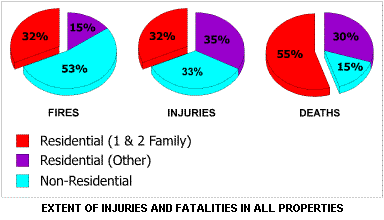 |
|||
| Causes of fatal residential fires | The National Fire Protection Association (NFPA) compiled a chart of general causes of residential fires resulting in one or more fatalities. | ||
|
|||
| Locations where fatal fires start | Another compilation by the NFPA lists areas within one and two family homes where fatal fires have been known to originate. | ||
|
|||
| Time distribution of residential fires | The NFPA also compiled a graph indicating the average distribution of fires over a 24-hour period. | ||
|
|||
| This shows clearly that, although only 10% of residential fires occur between 10pm and 6am (when most people are sleeping), 58% of the fatalities occur at this time. | |||
| Smoking | |||
| According to the NFPA, careless smoking habits have been responsible for 56% of all residential fires in which loss of life has occurred. Of these fatalities, 46% resulted from burning bedding, 43% from burning upholstery, and 7% from burning clothing. If you have a smoker in your household, it is clear from the statistics that you run a far greater risk of having a serious fire than if all your family members were non-smokers. It is, therefore, particularly important that you and your family be prepared for a fire situation. Ensure that the smoker(s) in your house, and smoking visitors to your house, use common sense, are not careless with their smoking materials, and adhere to the recommendations of Chapter 3. | |||
| Impairment | |||
| Excessive use of alcohol, drugs or medication is responsible for a fair number of residential fires in which fatalities occur. In fact, a study by the NFPA showed that, of 29 persons between the ages of 16 and 60 who died from fire, 24 (82.8%) were, or had been, consuming alcoholic beverages at the time of death. Lack of judgement and/or drowsiness while using smoking materials, cooking or electrical equipment can result in a fire situation. In addition, the sound of a smoke detector may not awaken a drugged sleeper and, even if it did, the person may not be able to make it to a safe exit. | |||
| Low Traffic Areas | |||
| A quarter of all fatal fires start in the basement, so ensure that smoke detectors are installed in areas that are normally unattended and that they are capable of wakening sleepers in all the bedroom areas. Also ensure that smoke detectors are installed in areas where fires can occur while you and your family are asleep. See Chapter 5. | |||
| Arson | |||
| Arson is Canada’s fastest growing crime. In 1984 there were more than 9000 arson fires, causing 45 deaths and 474 injuries. That amounts to 13% of all reported fires for that year. Most of the losses are on industrial and commercial property - but many are on residential homes, and these are the ones where life is most threatened. Almost half of all arson fires are set by vandals, but some are set to defraud insurance companies, or to cover up a crime, or for revenge against employers, landlords or even neighbours. The average homeowner is more likely to be hit by vandals out to "have a good time". Arson is usually a crime of opportunity, so it is impossible to predict when and where the vandals will strike. However, you can take defensive measures to reduce the likelihood of you and your family becoming victims of the arsonist. These measures include carrying out the recommendations of this document, and taking the same steps to discourage the arsonist as you would to discourage a burglar (see "Volume 2 - Security and Burglary Protection for the Home Owner"). | |||
| House Numbers | |||
| Make sure that police, fire and paramedics can find your home easily in a time of emergency. Have your house numbers clearly mounted on a high contrast background so that they are visible from the street, and have them illuminated at night. | |||
| Property Record | |||
| It is important to keep an accurate record of household and personal property for insurance purposes in the event of a fire or burglary. Record all your household and personal items on an inventory list, and include the make, model and serial numbers of the items if they are so marked. Save receipts from the purchase of your most valuable items and have expensive jewellery appraised. Record the actual or estimated replacement cost beside each item. Keep the inventory list (together with the receipts and appraisal certificates) in a safe-deposit box in your local bank, and update the list at least once a year, or when you acquire new items of value. A typical form is given in Appendix A. Property record forms are also available free of charge from the Insurance Bureau of Canada. You can also purchase inventory plan books that will allow you to combine a property list with photographs of your valuables. | |||
| Fire Insurance | |||
| While there are policies to cover practically every situation, the four primary home insurance policies are (a) the fire insurance policy, (b) the standard homeowner’s package policy, (c) the comparable tenant’s package policy, and (d) the condominium unit owner’s package policy. The package policies all protect your dwelling and possessions against the same perils as the fire insurance policy, but also include theft and personal liability. One premium is paid for the overall coverage. | |||
| The Fire Insurance Policy | This not only protects your dwelling and personal property against loss or damage by fire, but also covers loss or damage caused by explosion, falling objects, impact by vehicle, lightning, riot, water escape, vandalism, windstorm and smoke damage, all as defined in the policy. Under normal circumstances, in an urban area, there is no charge levied by the Fire Department when attending a fire within the same municipality as the fire hall. But, if fire trucks have to leave their home municipality, the homeowner may be charged a fee, and this is usually covered by the insurance company up to a specified limit (probably $500). In most urban areas all houses are within 1000 feet of a fire hydrant and within 5 miles of the nearest fire hall. If your house is outside these limits, as it might be in many rural areas, your insurance company may increase your basic premium based on the distances involved. The age of your home may also have a bearing on the premium you have to pay (for instance, a house that is less than 22 years old may qualify you for a 20% discount). Insurance companies differ greatly in the cost of the basic premium and in the type of discounts that are available. Factors that may affect the premium of your insurance policy are given later in this section. | ||
| Insuring to value | This is buying sufficient home insurance to cover your dwelling and personal property for their full current value. In the case of your dwelling, it means the amount of insurance necessary to replace your building with one of similar type and quality. In the case of personal property, unless you purchase replacement cost insurance, you will only be covered for the actual cash value at the time of loss - this will usually be determined by taking the current value and reducing the amount by the appropriate devaluation. Replacement cost insurance is highly recommended, and is usually available as an option by endorsement. Personal property will then be covered without deduction for depreciation. | ||
| Amount of coverage | You should insure your dwelling and personal property to full replacement value. To determine the value of your dwelling, you should probably have it appraised by a qualified appraiser. Remember, you are not appraising the sale value of your property, but the present day rebuilding costs of the building (the land is not normally insured). To establish the value of your personal property, refer to your property record sheet (see above). It may be necessary to purchase additional coverage for jewellery and other valuables if the replacement cost exceeds the limits of the policy for certain items. | ||
| Discounts | It is important to
"shop around" before selecting a home insurance package policy. You must take
into account the basic premium, together with whatever discounts the insurance company
offers for the type of construction of your home and the security measures you have taken
to protect your home against fire and burglary. Factors that may affect your premium are
as follows:
|
||
| Further information | For further general information on home insurance refer to the booklet "Home Insurance Explained", which is available free from the Insurance Bureau of Canada. | ||
| Residential Occupancies Other Than House Owner | |||
| Although this document was written specifically for the person who owns his own single family detached house, it also applies in some degree to the apartment owner, apartment renter, house renter and mobile home dweller. | |||
| House renter | If you are renting the whole house, ask the owner if he would consider installing the necessary fire equipment outlined in this document - even if it only complies with the minimum requirements. If you are renting only part of a house, or a section of a duplex or fourplex, etc., ask the owner to install at least minimal protection devices in all areas of the building. If he will not do this, there is no reason why you (and your neighbours living in other areas of the building) can’t install your own devices as long as you get permission to drill any necessary holes. The owner might consent to pay for the equipment if you install it - after all, it will be protecting his property as well. Remember that the fire safety precautions and escape plans are up to you, and can be carried out without approval. | ||
| Apartment owner | If you own a condominium-type or strata-title apartment, it is likely that the common property already has fire protection equipment installed. It is also possible that the apartments themselves are equipped with smoke detectors. Designate a member of your committee to be responsible for fire safety in your complex. He should check that the proper equipment is installed in the common property and that the proper safety precautions are adhered to. He may wish to hold meetings to advise owners on how best to prevent fires starting in their apartments and how to protect themselves should a fire start. Such information can be based on the methods contained in this document. | ||
| Apartment renter | Make yourself familiar with the fire protection equipment installed in the common areas. Locate the nearest fire extinguisher and read the instructions, then locate the nearest alarm switch. Are smoke detectors installed in the common areas? Install a smoke detector outside your sleeping area, getting permission to drill holes where necessary. The owner might consent to pay for the equipment if you install it - after all, it will be protecting his property as well. Remember that the fire safety precautions and escape plans are up to you, and can be carried out without approval. | ||
| Mobile home owner or renter | If you reside in a mobile home or trailer, fire can be a real threat. At least two smoke detectors should be strategically placed in accordance with this document, and it is recommended that consideration be given to purchasing a propane gas-leak detector if this type of fuel is used. One ABC-type fire extinguisher should be centrally located near an exit doorway. More than one extinguisher is recommended. Adhere to the fire safety precautions and make escape plans per this report. | ||
| Regulations on the Sale and Use of Fire Safety Equipment | |||
| In order to ensure a standard of quality, performance and safety in products sold to and used by the consumer, certification services are provided by a number of organisations in Canada and around the world. These organisations will examine, test and classify certain products and, upon the product meeting the requirements, will allow the product to be labelled appropriately. The consumer is urged to purchase and use only products that bear the certification markings (where applicable) for their own safety and to ensure that a standard of quality and performance is met. In many cases, a standard may be adopted by a government agency or other regulatory body, so that the sale or use of a product that has not been certified may be prohibited under law. | |||
| Canadian regulations | In Canada, certification services are provided by The Underwriters’ Laboratories of Canada (ULC), The Canadian Standards Association (CSA), The Canadian General Standards Board (CGSB), The Canadian Gas Association (CGA) and others. A few of the standards produced by these organisations are enforced by the Office of Consumer and Corporate Affairs in The Hazardous Products Act that may ban or regulate products not meeting the standards. | ||
| Provincial and Municipal regulations | In addition to Canadian regulations and acts, the local governments enforce laws on the sale and use of potentially hazardous products. They may reference the standards of organisations offering certification services or create their own. | ||
| Regulations for fire safety | As an example, The Hazardous Products Act states that no person shall advertise, sell or import into Canada smoke alarms (and other types of fire alarm systems) for household use that do not meet the applicable standards of the ULC - hence, all such devices sold and used in Canada must bear the ULC logo. Also banned under this Act are products made of textile fibres and childrens’ sleepwear that do not meet the flammability requirements of the CGSB. Although not a mandatory requirement of the Canadian government, it is highly recommended that you purchase only ac-powered electrical appliances that bear the CSA certification mark. | ||
| Please read Disclaimer | |||
